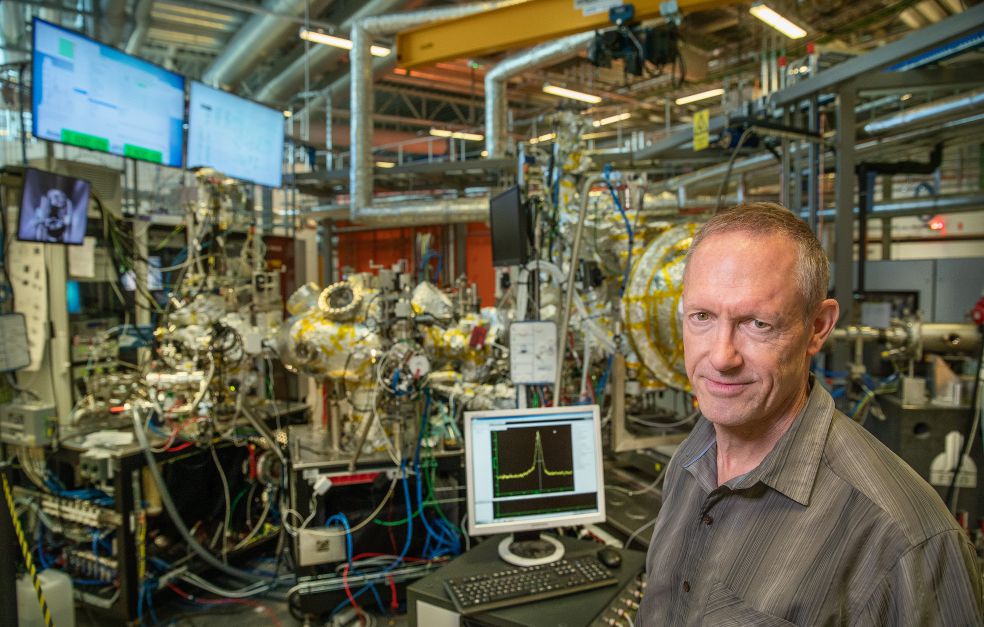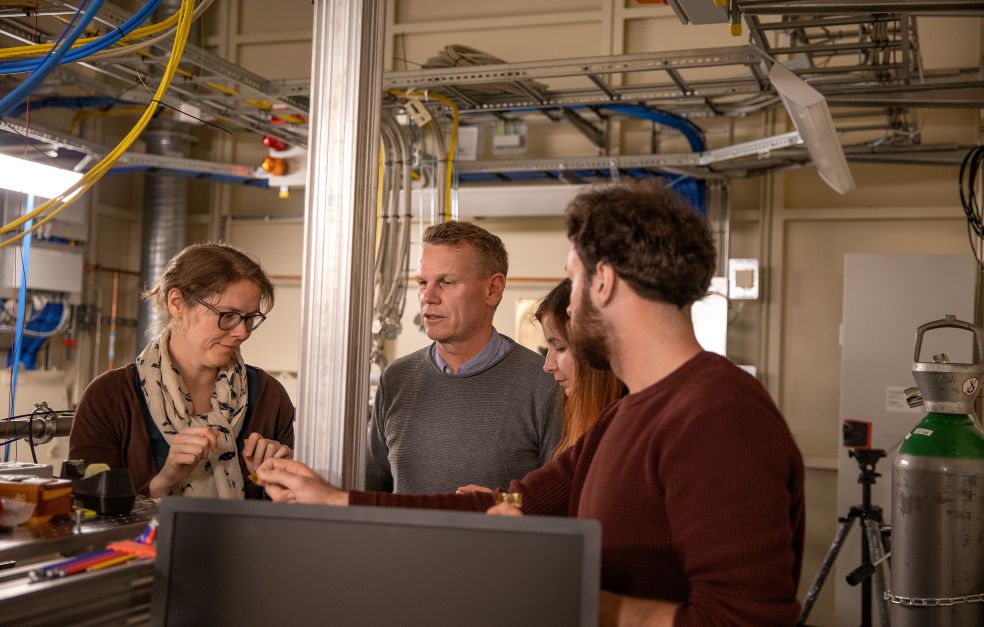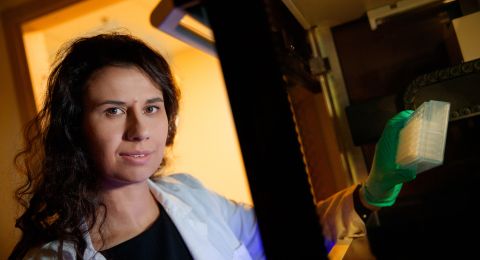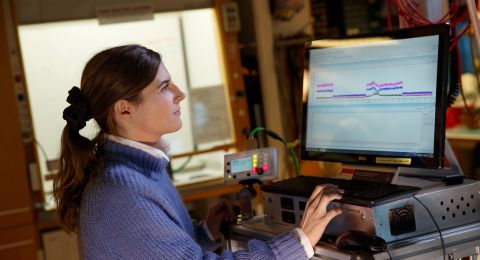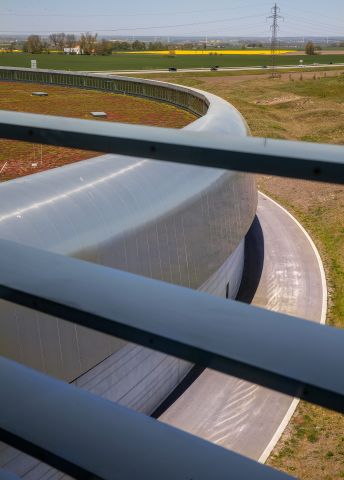
Synchrotron light
MAX IV is a national facility whose design and construction have been funded by the Swedish Research Council, Vinnova – Sweden’s Innovation Agency, Lund University and Skåne County Council.
Operation of the facility is largely funded by the Swedish Research Council and Swedish universities.
The Foundation has granted a total of more than SEK 1 billion to the MAX Laboratory. The latest contribution involves radiation tubes for the new MAX IV facility.
Each beamline costs between SEK 90 and SEK 150 million to build. Funding for the beamlines comes from Knut and Alice Wallenberg Foundation, the Swedish Research Council, Swedish universities, and from trade and industry.
The landscape around MAX IV is gently undulating, with low hills intended to dampen the vibrations from the E22 highway. The facility is dominated by a circular building the size of the Colosseum, with a circumference of 528 meters. It houses the storage ring, a type of particle accelerator in which electrons circulate close to the speed of light. Magnets deflect their trajectory, which makes them emit high-energy light: synchrotron light. The light is guided through beamlines to experimental stations, and is used in numerous scientific fields to analyze materials. The X-ray beams at MAX IV are brighter than at any previous research facility, which means the light they produce is stronger, and more focused.
“The vision of creating such an intense synchrotron light source existed in several places across the world, but MAX IV was the one to take the risk and do it. When others saw that it worked, there was growing interest in the unique opportunities here, and in investing in the facility. Now we have funding for sixteen beamlines, compared with the seven that were originally planned. It’s just amazing,” says Ian McNulty, Director of MAX IV.
MAX IV is a Swedish national facility, with Knut and Alice Wallenberg Foundation as one of its major funding bodies. The facility attracts physicists, biologists, environmental scientists, archaeologists, chemists, biochemists, art historians, paleontologists and many others. Each beamline is operated by a handful of employees who possess expert knowledge of the equipment and the research methods. Researchers from around the world submit applications to conduct experiments, and an external, international expert group selects applicants who will be given beam time. Those who intend to publish their findings use MAX IV free of charge, regardless of whether their project is being conducted in the academic world or is funded by industry. Only those wishing to keep their findings secret need pay to use the facility.
Precision – an asset and a challenge
Lars Johansson, Professor of Mathematics at Karlstad University, is working at the Bloch beamline, named for the Nobel laureate Felix Bloch. His team is studying quantum mechanical effects in ultrathin metal surfaces on semiconductors. This is basic research, but is of great interest to the semiconductor industry, which needs to take quantum mechanics into account when manufacturing increasingly microscopic electronic components.
But at the moment the analysis technology itself is more important than the results.
“I worked at MAX IV’s predecessor – the MAX laboratory – but much of the technology here is new, and we need to learn how to use it. Higher performance and more automation yields huge advantages, but also creates some issues, and the equipment needs a fair amount of fine tuning,” Johansson comments.
The new facility offers long-awaited high precision, but this is also a challenge. The beam striking the sample is extremely narrow, and the detector receiving the light when it comes out also scans a very small area. The sample must be placed just right, with a margin of error of under one-tenth of a millimeter.
The beamlines and experiment stations have been developed for studies of various kinds. ForMAX, for instance, is used to analyze wood fibers. It was built with funding from Knut and Alice Wallenberg Foundation, but the Swedish pulp and paper industry will be paying for its operation. The MicroMAX beamline focuses on structural biology, and is funded by the Novo Nordisk Foundation.
“They are also covering operation costs for ten years. That shows how sure they are that MAX IV will offer medicine and health sciences something far beyond what we see today,” McNulty says.
The Balder beamline has broad applications, from catalytic research to energy science, environmental science and life science. It is being used by Per Persson, Professor of Molecular Geochemistry, to study the forms in which iron occurs in nature, e.g. in water samples. The capacity of MAX IV reduces the need to concentrate the samples, and enables scientists to study them in a more natural form.
“As a researcher based in Lund, the proximity to MAX IV is definitely a positive – I can bike here in ten minutes. Being so close by gives us greater scope for development work. We are currently working on new methods of analyzing environmental samples,” Persson says.
Sixteen beamlines within five years
MAX IV has faced challenges. Some parts of the work were delayed. The situation was not communicated clearly enough, which resulted in a change of director. It was at that point that Ian McNulty, newly appointed Physical Science Director, took over responsibility for the entire facility.
“Perhaps the enthusiasm on which the whole initiative was founded led to a somewhat optimistic timetable. After all, this facility is based on truly cutting-edge technology, which needed to be designed from scratch. Now we make sure to open one area at a time, and keep our users and funding bodies constantly updated on the timetable,” McNulty explains.
In five years he expects sixteen beamlines to be fully operational, with a further four or five in different stages of planning and construction. In ten years’ time he envisions that the facility will also have been expanded to include X-ray laser, a technology used a great deal by Swedish researchers, but not yet available in Sweden.
“Even now we have moved on from being designers of a facility to delivering high-class science – a long wait is over. Those who had the courage to invest in MAX IV and build it, were brave people with a vision. Now that vision has become a reality.”
Text Lisa Kirsebom
Translation Maxwell Arding
Photo Magnus Bergström
Synchrotron light
Synchrotron light is a strong light with a broad spectrum of wavelengths. At MAX IV it is produced by electrons that are accelerated almost to the speed of light and deflected using magnets. The deflection causes them to emit light, which is then guided through beamlines to experiment stations. There, the light is used to analyze structure and bonds in different materials. There are a number of facilities around the world that offer, or plan to offer, the same capabilities as MAX IV – in Brazil, France, the U.S. and elsewhere.
